Abstract
The beta-lactamases obtained from culture supernatants and cell extracts of 26 clinical strains and 5 reference strains of Nocardia farcinica were partially characterized. The enzymes exhibited two patterns on isoelectric focusing (IEF). beta-Lactamases from the majority of the 31 strains (87%) including the 5 reference strains exhibited two major bands with pIs of 4.56 and 4.49. The remaining strains had two similar major bands but with slightly higher pIs. Culture supernatants and cell extracts exhibited identical patterns. The two sets of enzymes were functionally indistinguishable by substrate and inhibitor profiles and lack of inducibility. By disk testing, ampicillin, amoxicillin, ticarcillin, amoxicillin-clavulanic acid, and imipenem were highly synergistic with cefotaxime. The enzymes were primarily penicillinases and hydrolyzed cephalosporins at rates of < or = 12% of those for penicillins. N. farcinica beta-lactamases were susceptible to inhibition by clavulanic acid and BRL 42715, exhibiting 50% inhibitory concentrations of 0.025 to 0.045 micrograms/ml (0.12 to 0.22 microM) and 0.05 to 0.1 micrograms/ml (0.31 to 0.63 microM), respectively, less susceptible to tazobactam, and least susceptible to sulbactam, cloxacillin, and imipenem. The beta-lactamases of N. farcinica are believed to mediate penicillin resistance and may play a secondary role in extended-spectrum cephalosporin resistance. The close similarity among N. farcinica beta-lactamases and their distinct differences from beta-lactamases of other Nocardia species support the taxonomic identity of this species.
Full text
PDF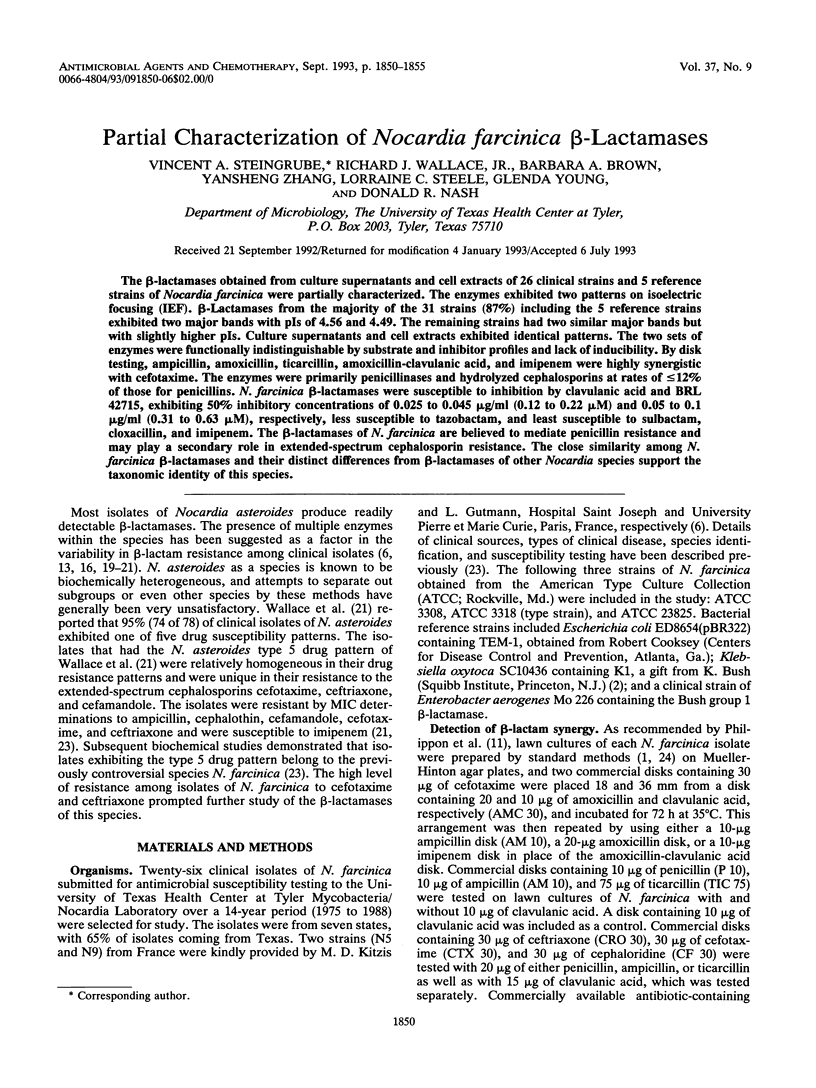
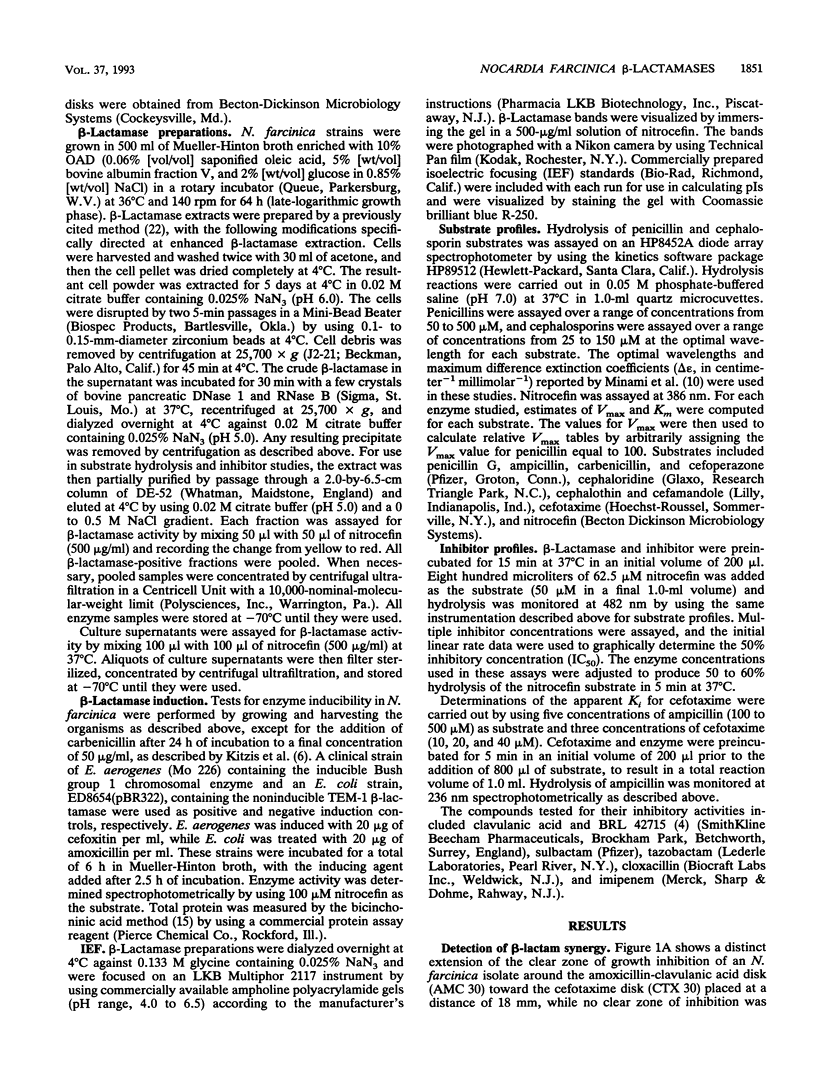
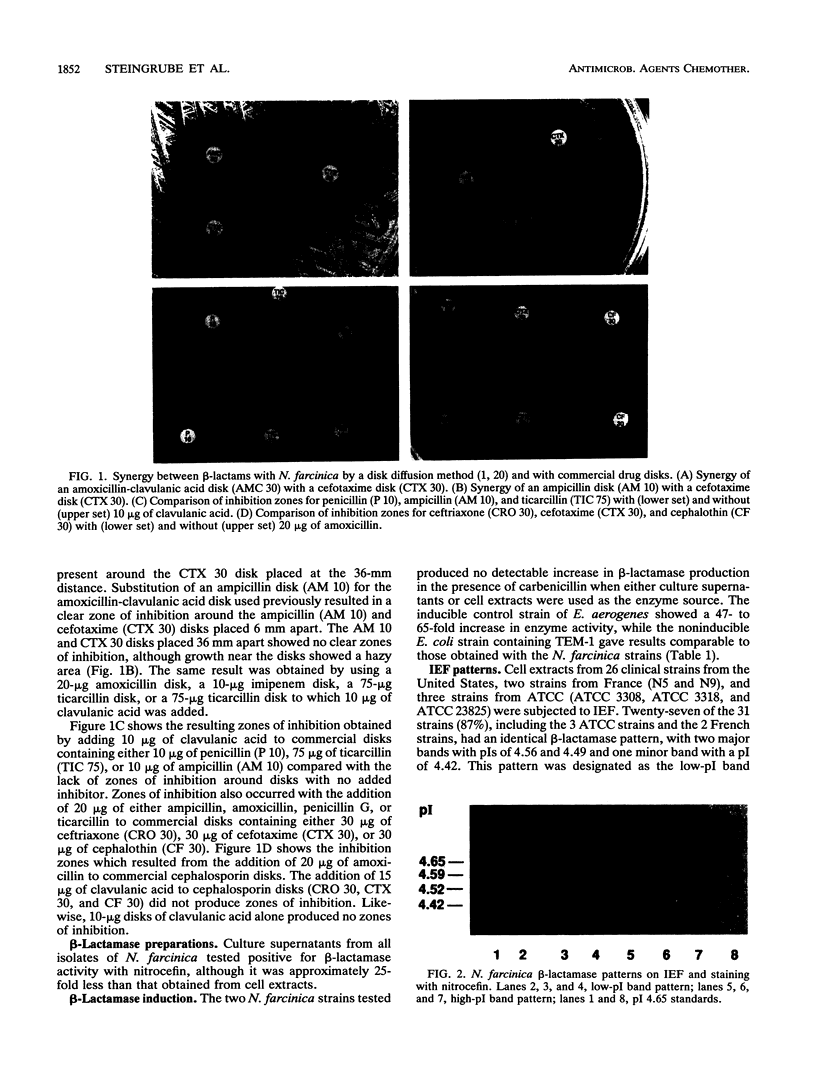
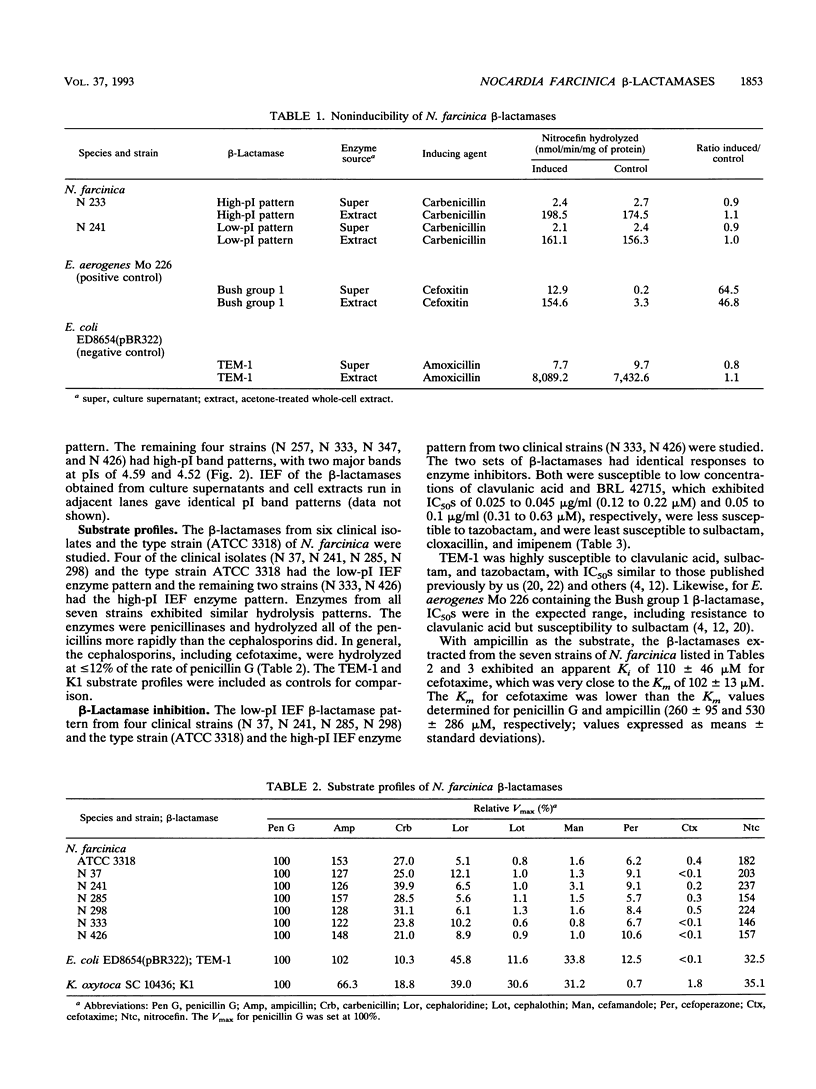
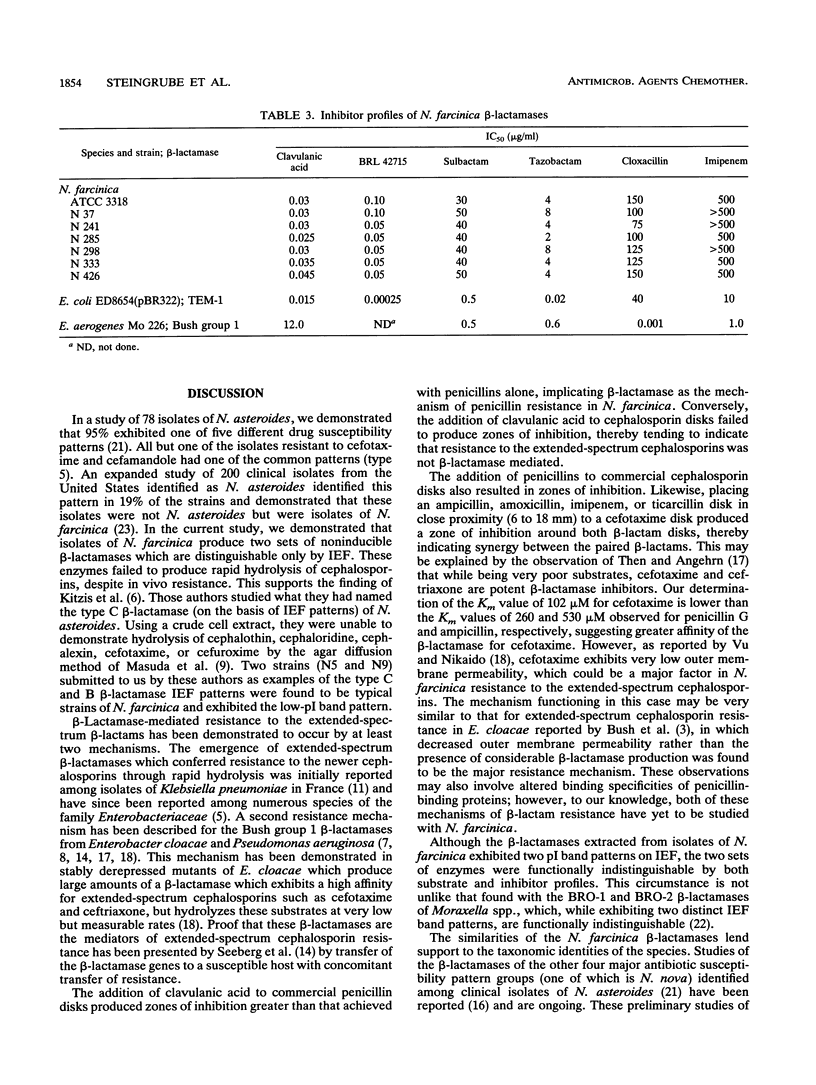
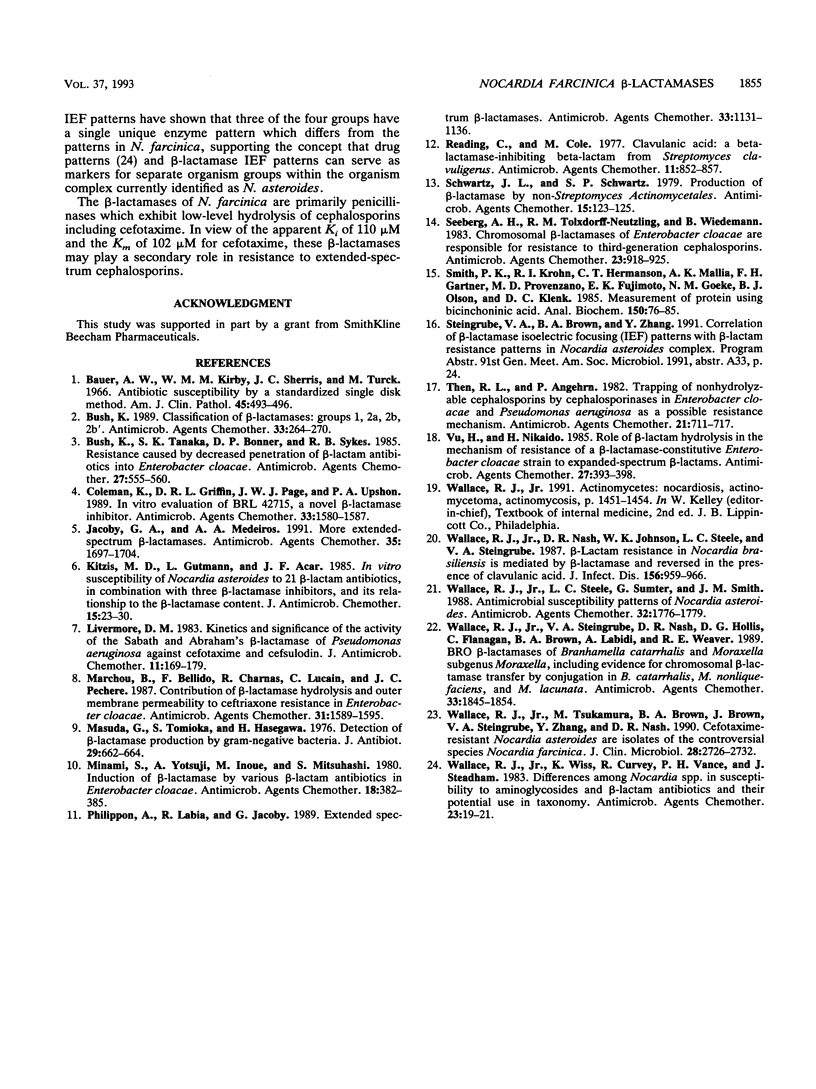
Images in this article
Selected References
These references are in PubMed. This may not be the complete list of references from this article.
- Bauer A. W., Kirby W. M., Sherris J. C., Turck M. Antibiotic susceptibility testing by a standardized single disk method. Am J Clin Pathol. 1966 Apr;45(4):493–496. [PubMed] [Google Scholar]
- Bush K. Classification of beta-lactamases: groups 1, 2a, 2b, and 2b'. Antimicrob Agents Chemother. 1989 Mar;33(3):264–270. doi: 10.1128/aac.33.3.264. [DOI] [PMC free article] [PubMed] [Google Scholar]
- Bush K., Tanaka S. K., Bonner D. P., Sykes R. B. Resistance caused by decreased penetration of beta-lactam antibiotics into Enterobacter cloacae. Antimicrob Agents Chemother. 1985 Apr;27(4):555–560. doi: 10.1128/aac.27.4.555. [DOI] [PMC free article] [PubMed] [Google Scholar]
- Coleman K., Griffin D. R., Page J. W., Upshon P. A. In vitro evaluation of BRL 42715, a novel beta-lactamase inhibitor. Antimicrob Agents Chemother. 1989 Sep;33(9):1580–1587. doi: 10.1128/aac.33.9.1580. [DOI] [PMC free article] [PubMed] [Google Scholar]
- Jacoby G. A., Medeiros A. A. More extended-spectrum beta-lactamases. Antimicrob Agents Chemother. 1991 Sep;35(9):1697–1704. doi: 10.1128/aac.35.9.1697. [DOI] [PMC free article] [PubMed] [Google Scholar]
- Kitzis M. D., Gutmann L., Acar J. F. In-vitro susceptibility of Nocardia asteroides to 21 beta-lactam antibiotics, in combination with three beta-lactamase inhibitors, and its relationship to the beta-lactamase content. J Antimicrob Chemother. 1985 Jan;15(1):23–30. doi: 10.1093/jac/15.1.23. [DOI] [PubMed] [Google Scholar]
- Livermore D. M. Kinetics and significance of the activity of the Sabath and Abrahams' beta-lactamase of Pseudomonas aeruginosa against cefotaxime and cefsulodin. J Antimicrob Chemother. 1983 Feb;11(2):169–179. doi: 10.1093/jac/11.2.169. [DOI] [PubMed] [Google Scholar]
- Marchou B., Bellido F., Charnas R., Lucain C., Pechère J. C. Contribution of beta-lactamase hydrolysis and outer membrane permeability to ceftriaxone resistance in Enterobacter cloacae. Antimicrob Agents Chemother. 1987 Oct;31(10):1589–1595. doi: 10.1128/aac.31.10.1589. [DOI] [PMC free article] [PubMed] [Google Scholar]
- Masuda G., Tomioka S., Hasegawa M. Detection of beta-lactamase production by gram-negative bacteria. J Antibiot (Tokyo) 1976 Jun;29(6):662–664. doi: 10.7164/antibiotics.29.662. [DOI] [PubMed] [Google Scholar]
- Minami S., Yotsuji A., Inoue M., Mitsuhashi S. Induction of beta-lactamase by various beta-lactam antibiotics in Enterobacter cloacae. Antimicrob Agents Chemother. 1980 Sep;18(3):382–385. doi: 10.1128/aac.18.3.382. [DOI] [PMC free article] [PubMed] [Google Scholar]
- Philippon A., Labia R., Jacoby G. Extended-spectrum beta-lactamases. Antimicrob Agents Chemother. 1989 Aug;33(8):1131–1136. doi: 10.1128/aac.33.8.1131. [DOI] [PMC free article] [PubMed] [Google Scholar]
- Reading C., Cole M. Clavulanic acid: a beta-lactamase-inhiting beta-lactam from Streptomyces clavuligerus. Antimicrob Agents Chemother. 1977 May;11(5):852–857. doi: 10.1128/aac.11.5.852. [DOI] [PMC free article] [PubMed] [Google Scholar]
- Schwartz J. L., Schwartz S. P. Production of beta-lactamase by non-streptomyces Actinomycetales. Antimicrob Agents Chemother. 1979 Jan;15(1):123–125. doi: 10.1128/aac.15.1.123. [DOI] [PMC free article] [PubMed] [Google Scholar]
- Seeberg A. H., Tolxdorff-Neutzling R. M., Wiedemann B. Chromosomal beta-lactamases of Enterobacter cloacae are responsible for resistance to third-generation cephalosporins. Antimicrob Agents Chemother. 1983 Jun;23(6):918–925. doi: 10.1128/aac.23.6.918. [DOI] [PMC free article] [PubMed] [Google Scholar]
- Smith P. K., Krohn R. I., Hermanson G. T., Mallia A. K., Gartner F. H., Provenzano M. D., Fujimoto E. K., Goeke N. M., Olson B. J., Klenk D. C. Measurement of protein using bicinchoninic acid. Anal Biochem. 1985 Oct;150(1):76–85. doi: 10.1016/0003-2697(85)90442-7. [DOI] [PubMed] [Google Scholar]
- Then R. L., Angehrn P. Trapping of nonhydrolyzable cephalosporins by cephalosporinases in Enterobacter cloacae and Pseudomonas aeruginosa as a possible resistance mechanism. Antimicrob Agents Chemother. 1982 May;21(5):711–717. doi: 10.1128/aac.21.5.711. [DOI] [PMC free article] [PubMed] [Google Scholar]
- Vu H., Nikaido H. Role of beta-lactam hydrolysis in the mechanism of resistance of a beta-lactamase-constitutive Enterobacter cloacae strain to expanded-spectrum beta-lactams. Antimicrob Agents Chemother. 1985 Mar;27(3):393–398. doi: 10.1128/aac.27.3.393. [DOI] [PMC free article] [PubMed] [Google Scholar]
- Wallace R. J., Jr, Nash D. R., Johnson W. K., Steele L. C., Steingrube V. A. Beta-lactam resistance in Nocardia brasiliensis is mediated by beta-lactamase and reversed in the presence of clavulanic acid. J Infect Dis. 1987 Dec;156(6):959–966. doi: 10.1093/infdis/156.6.959. [DOI] [PubMed] [Google Scholar]
- Wallace R. J., Jr, Steele L. C., Sumter G., Smith J. M. Antimicrobial susceptibility patterns of Nocardia asteroides. Antimicrob Agents Chemother. 1988 Dec;32(12):1776–1779. doi: 10.1128/aac.32.12.1776. [DOI] [PMC free article] [PubMed] [Google Scholar]
- Wallace R. J., Jr, Steingrube V. A., Nash D. R., Hollis D. G., Flanagan C., Brown B. A., Labidi A., Weaver R. E. BRO beta-lactamases of Branhamella catarrhalis and Moraxella subgenus Moraxella, including evidence for chromosomal beta-lactamase transfer by conjugation in B. catarrhalis, M. nonliquefaciens, and M. lacunata. Antimicrob Agents Chemother. 1989 Nov;33(11):1845–1854. doi: 10.1128/aac.33.11.1845. [DOI] [PMC free article] [PubMed] [Google Scholar]
- Wallace R. J., Jr, Tsukamura M., Brown B. A., Brown J., Steingrube V. A., Zhang Y. S., Nash D. R. Cefotaxime-resistant Nocardia asteroides strains are isolates of the controversial species Nocardia farcinica. J Clin Microbiol. 1990 Dec;28(12):2726–2732. doi: 10.1128/jcm.28.12.2726-2732.1990. [DOI] [PMC free article] [PubMed] [Google Scholar]
- Wallace R. J., Jr, Wiss K., Curvey R., Vance P. H., Steadham J. Differences among Nocardia spp. in susceptibility to aminoglycosides and beta-lactam antibiotics and their potential use in taxonomy. Antimicrob Agents Chemother. 1983 Jan;23(1):19–21. doi: 10.1128/aac.23.1.19. [DOI] [PMC free article] [PubMed] [Google Scholar]




